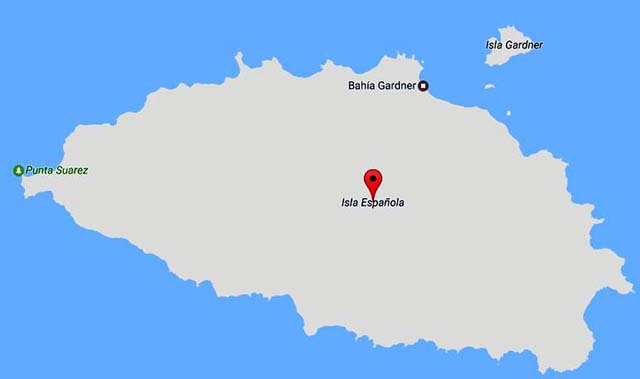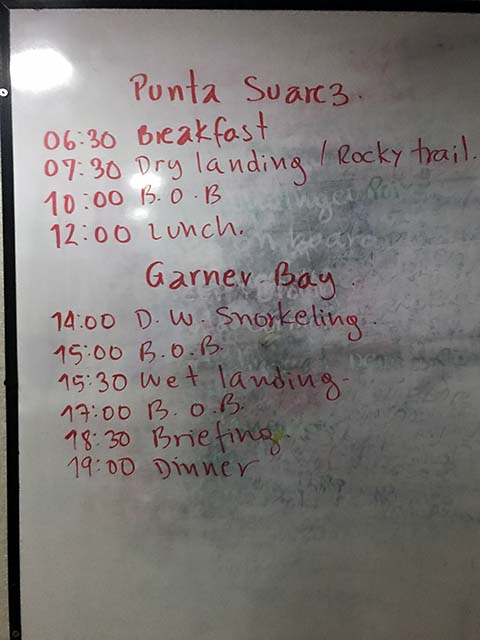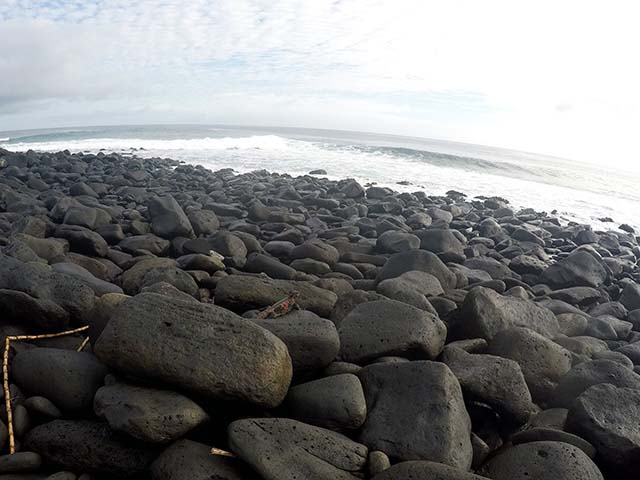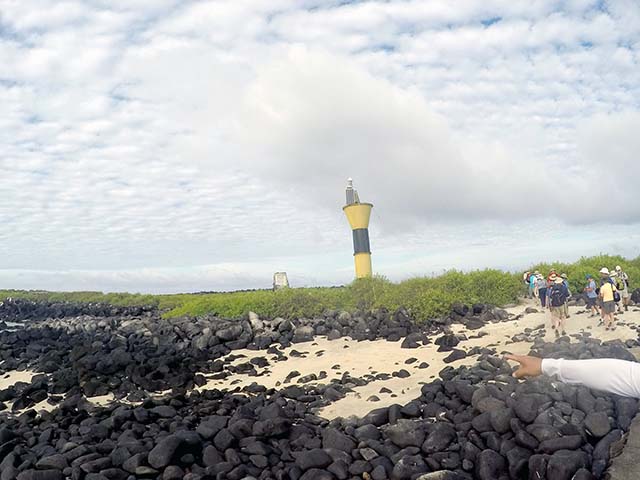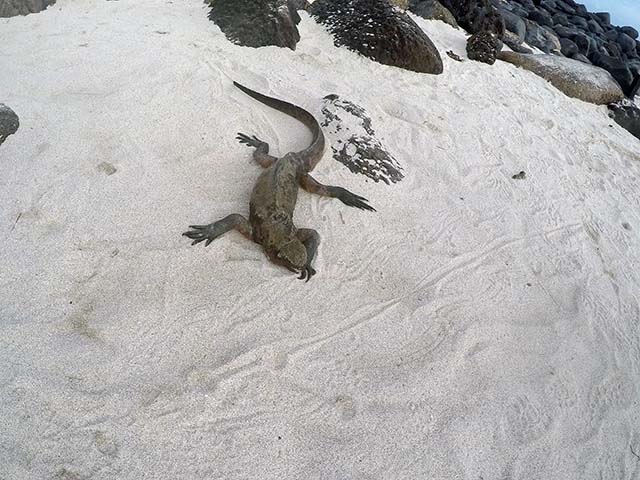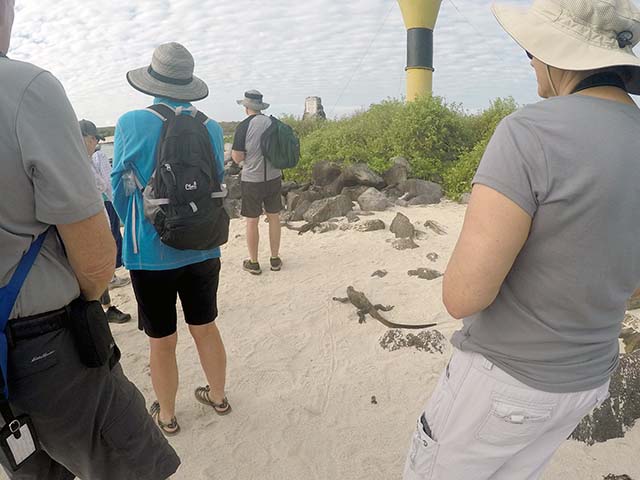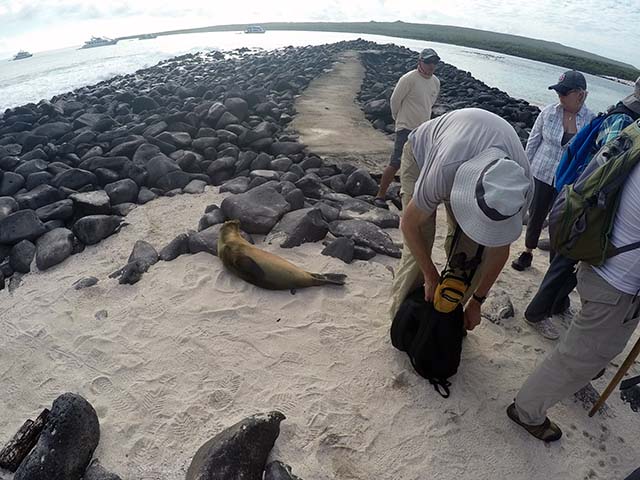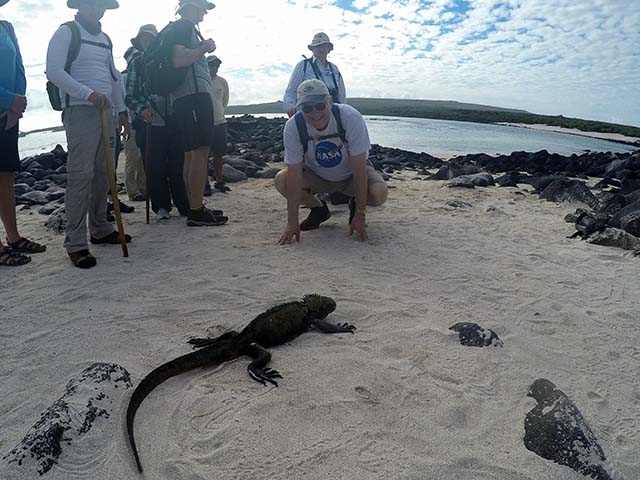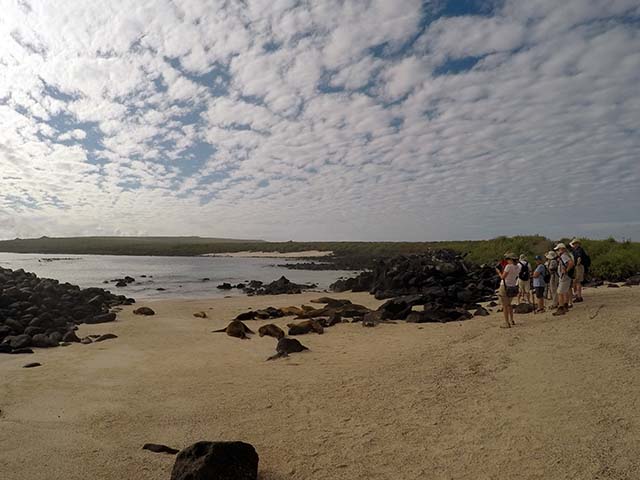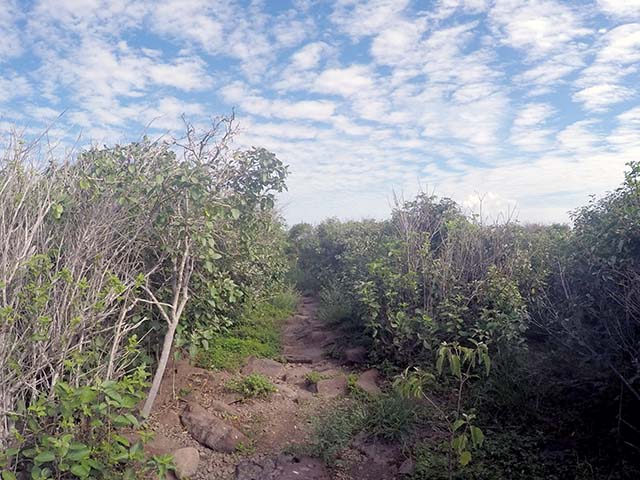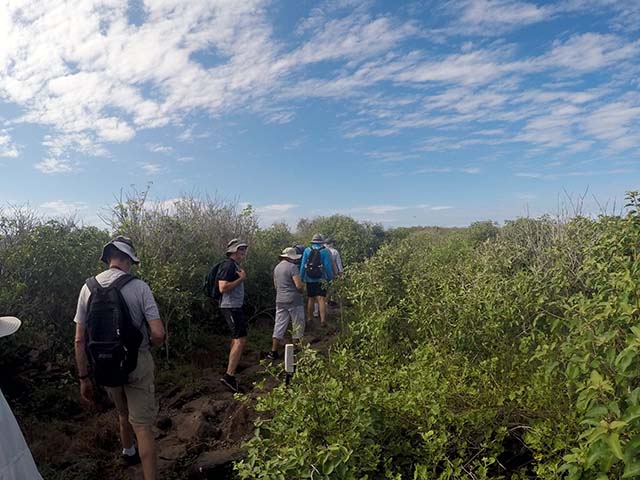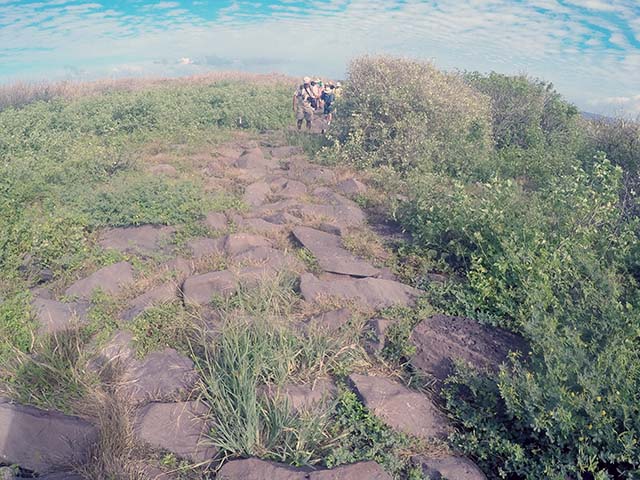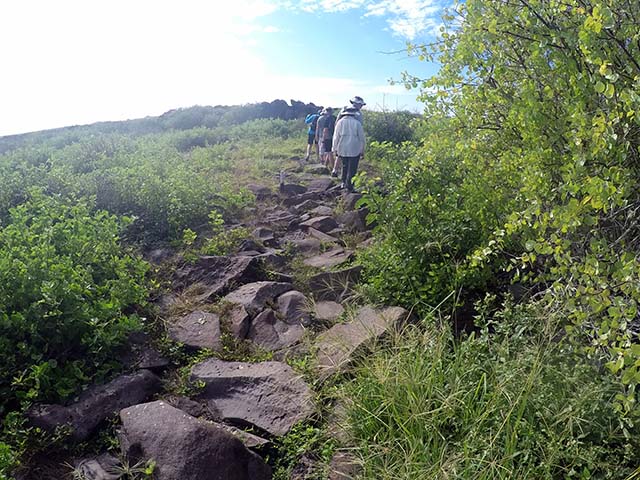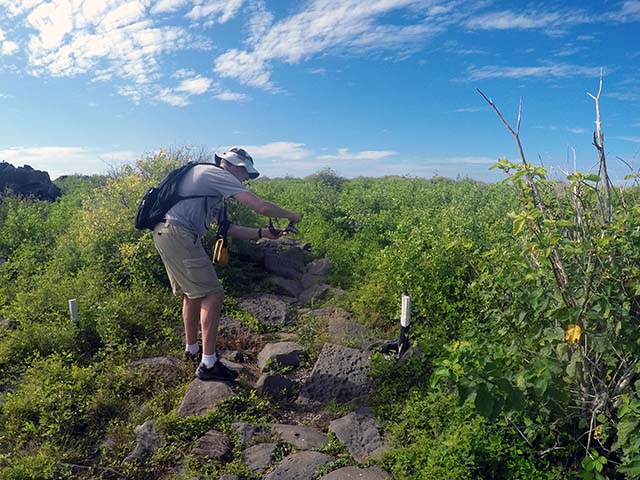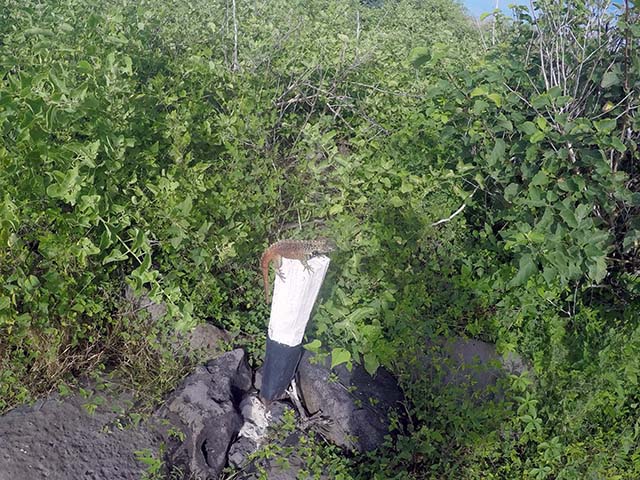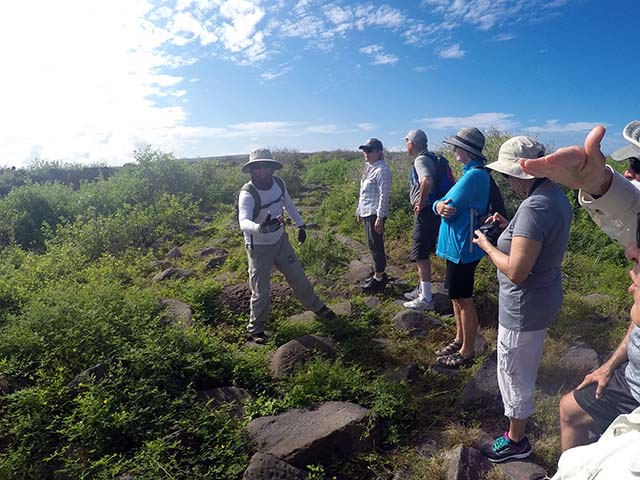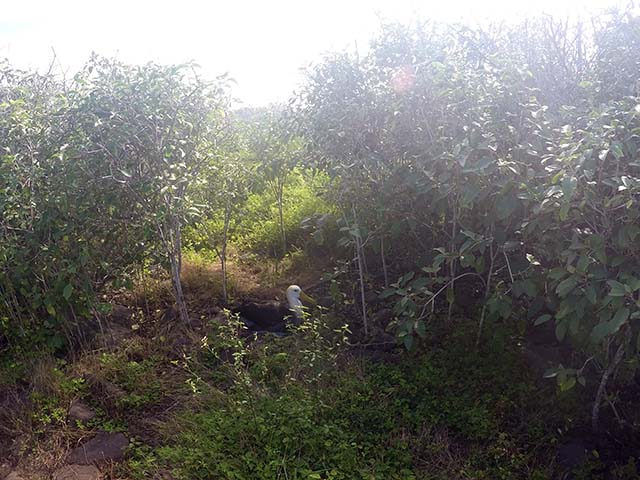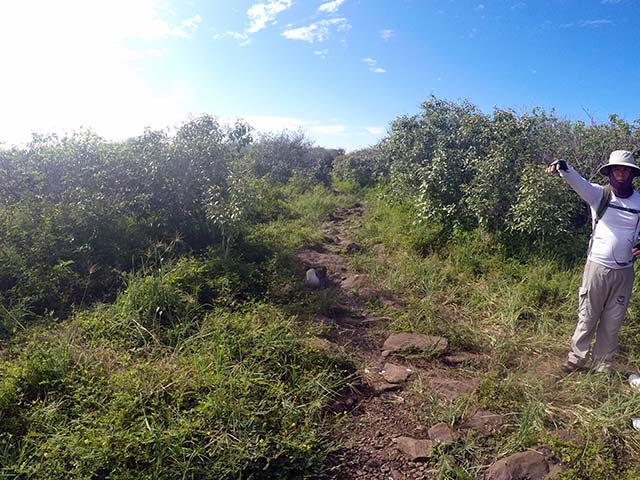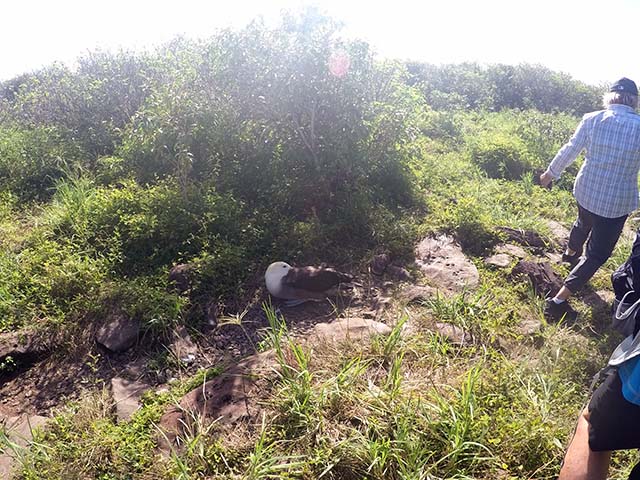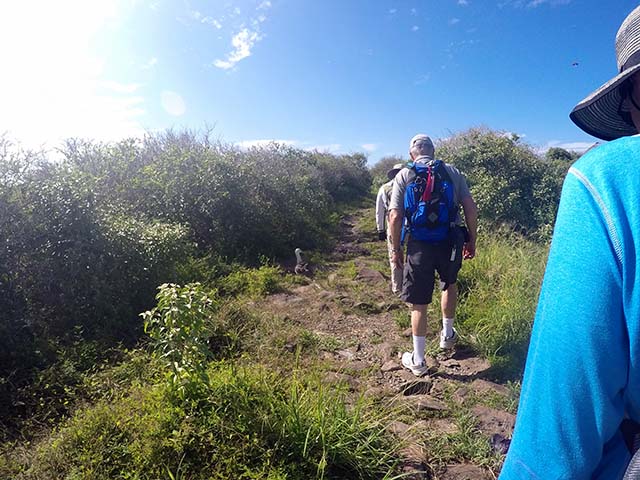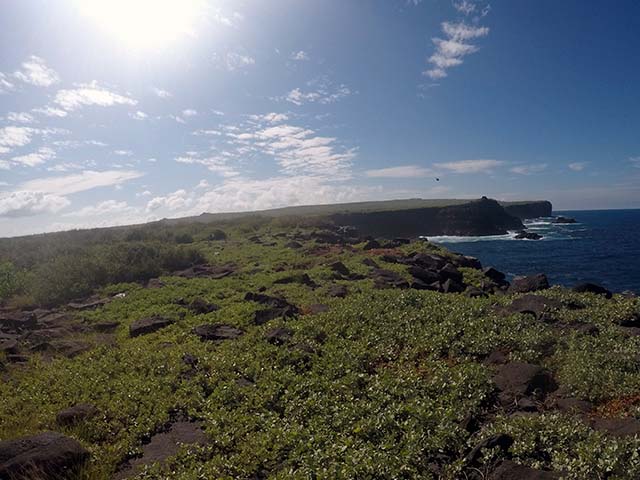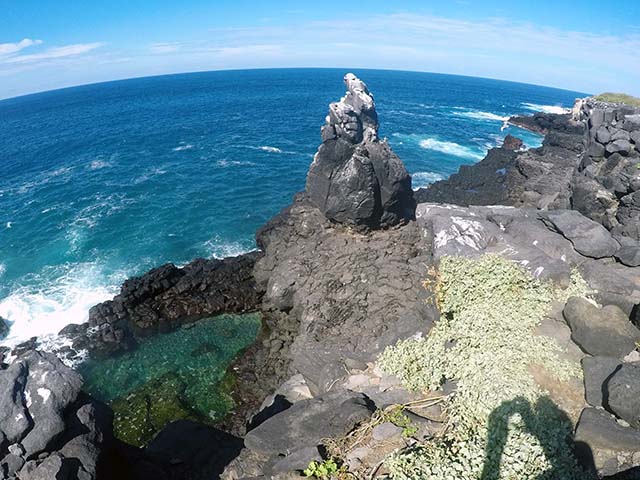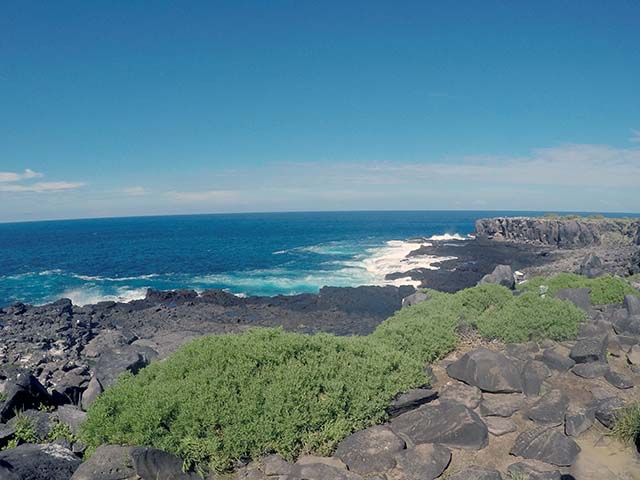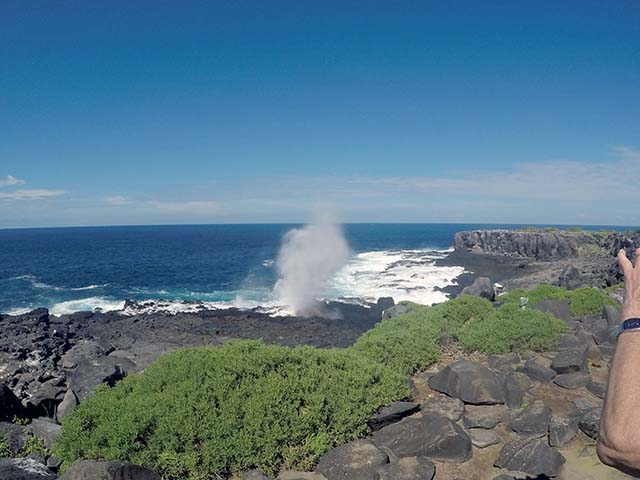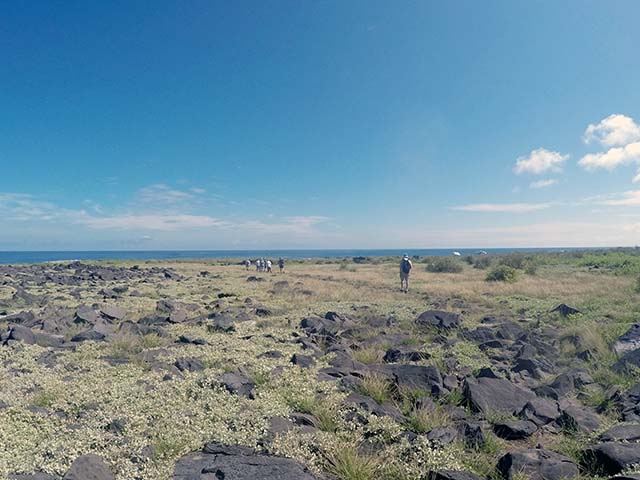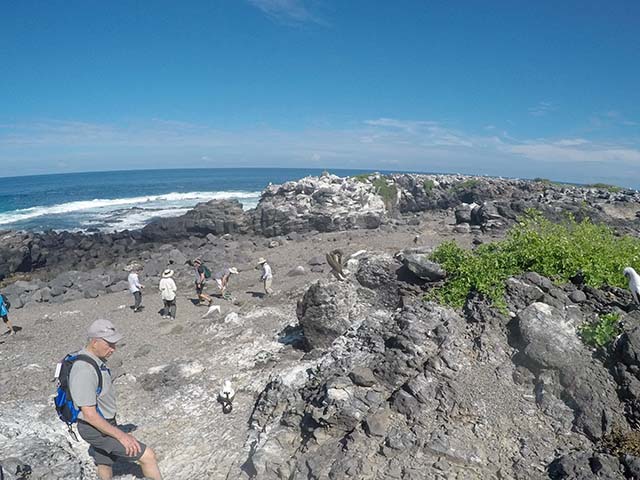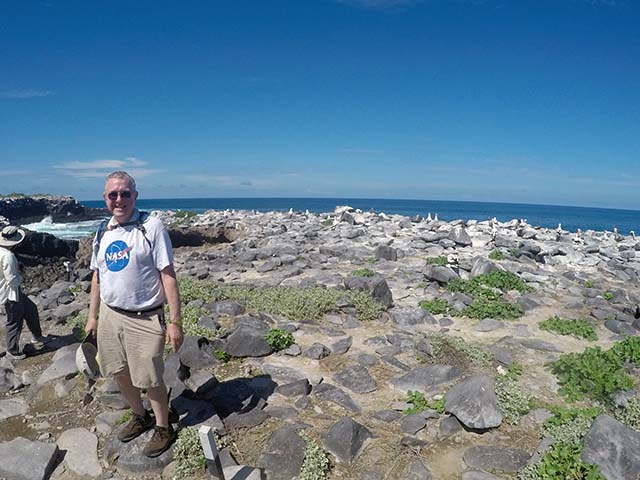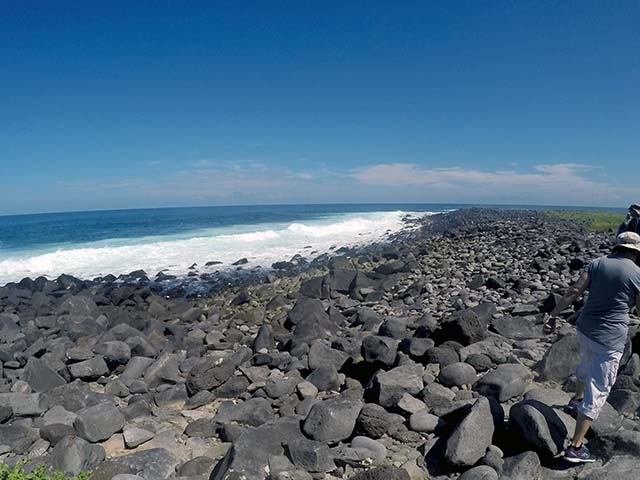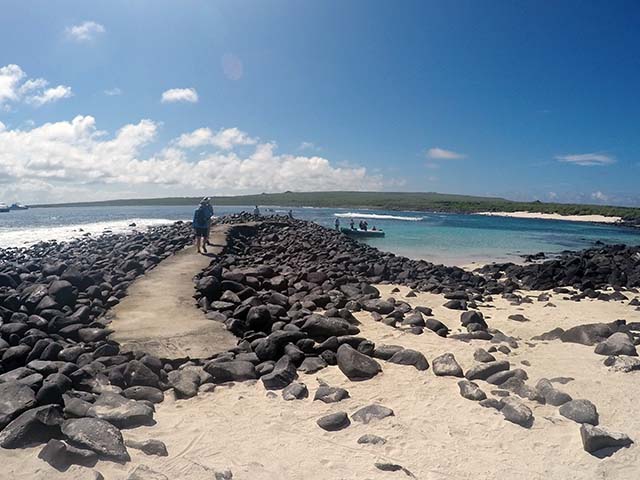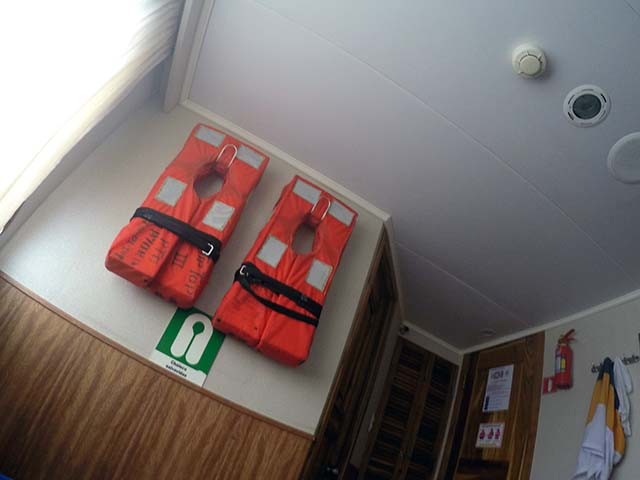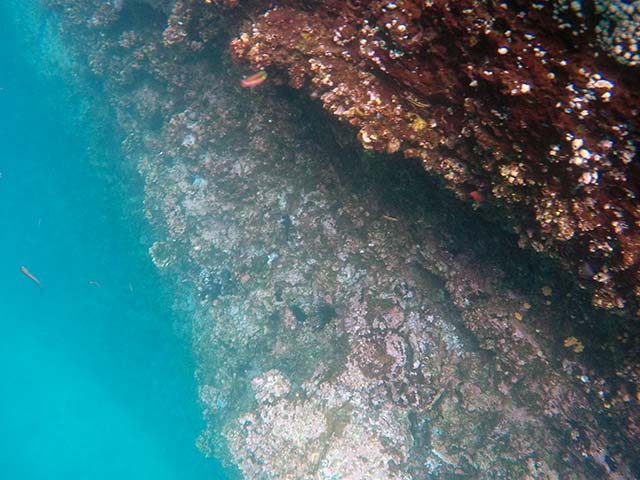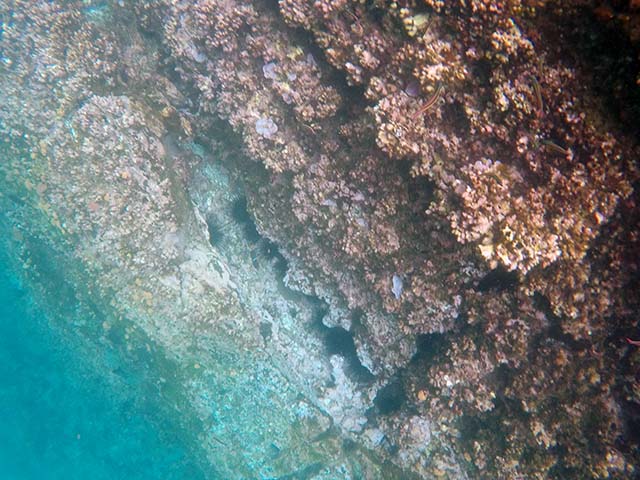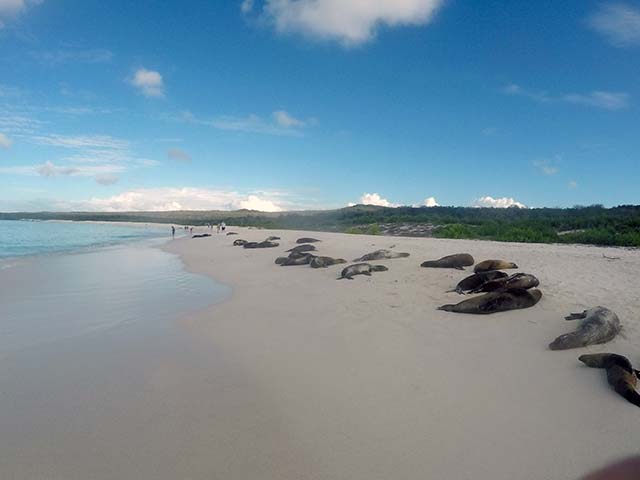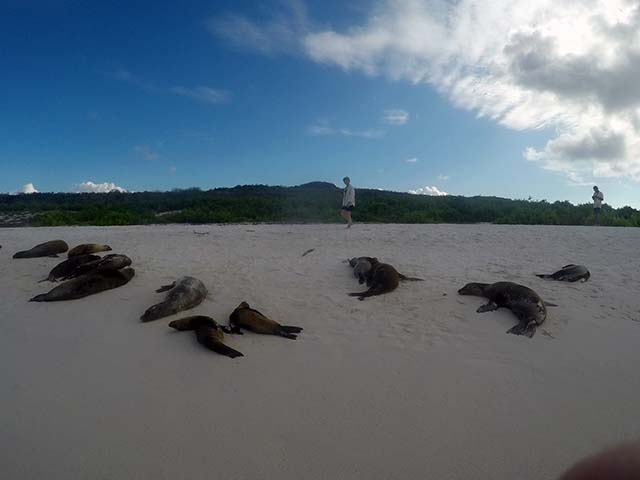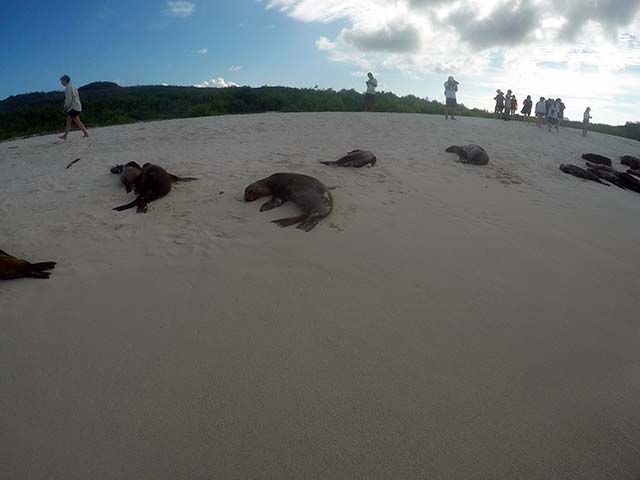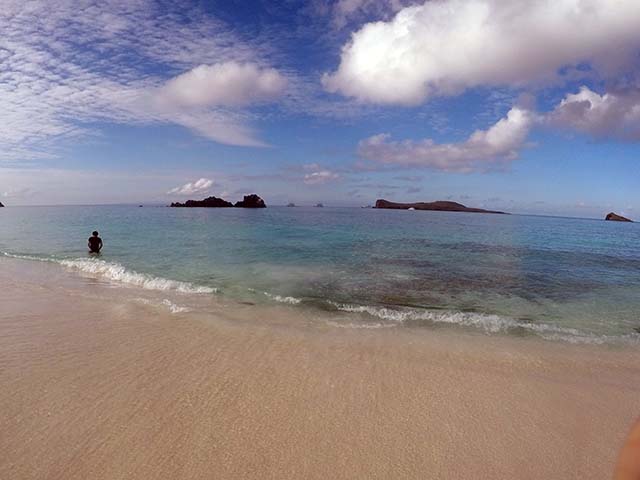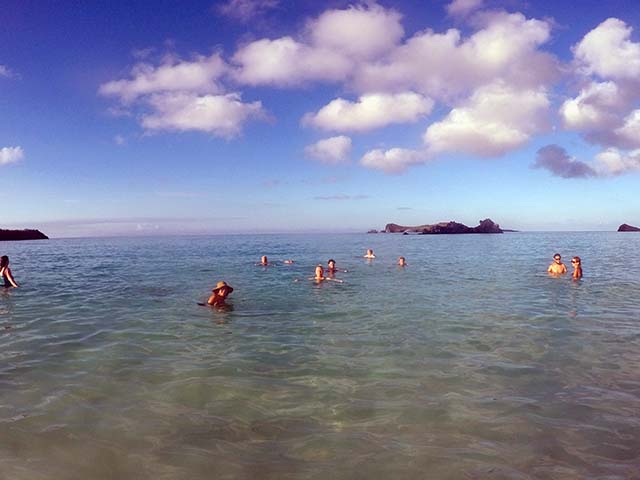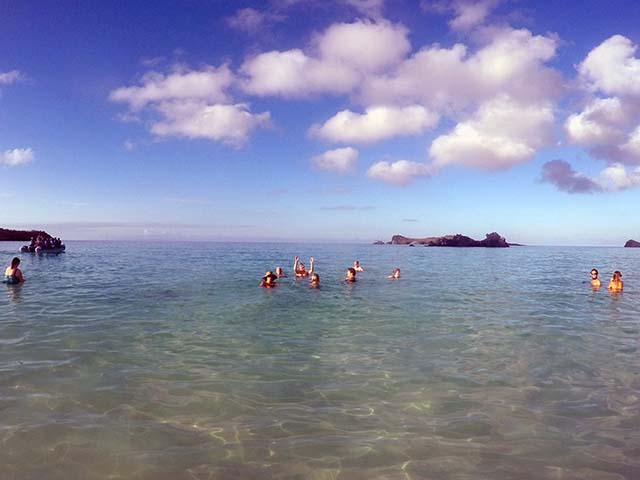|
Española Island (Spanish: Isla Española) is part of the Galápagos Islands. The English named it Hood Island after Viscount Samuel Hood. It is located in the extreme southeast of the archipelago and is considered, along with Santa Fe, one of the oldest, at approximately four million years. A popular tourist stop, Isla Española is the most southerly island in the Galápagos Archipelago. The climate is very dry, like most of the Archipelago. But due to the flatness of the island, it is the driest of these islands, with only a few inches of rain per year. It is about a 10- to 12-hour trip by boat from Isla Santa Cruz. Tourists come to see the waved albatrosses (from March to January, almost the entire world population breeds on the island) and the mating dances of blue-footed boobies on Española Island. While Española Island is one of the oldest of the Galápagos Islands, this island is dying, slowly becoming a rocky, barren land with little or no vegetation. But this does give large bays, with sand and soft shingle which attracts a healthy number of Galápagos sea lions Two spots are especially popular with visitors: Bahía Gardner, which has a lovely beach; and Punta Suárez, of interest because of its varied bird-life. This island has its own species of animals, such as the Española mockingbird, which has a longer and more curved beak than the one on the central islands; the Española lava lizard; the marine iguana of the subspecies venustissimus, which has red markings on its back; among others. Here there are also swallow-tailed gulls and other tropical birds.
More overnight travel, and now we've arrived at the Island of Española.
Here's Franklin's handwritten schedule for the day. We're going to start with a hike to Punta Suarez. One of the most popular visitor sites in Galapagos, Punta Suarez has an amazing variety and quantity of wildlife. Lazy sea lions may greet visitors at the rocky landing site, forcing visitors to step over or around them to get to the trail. Groups of young sea lions are often found nearby playing in the shallow water, waiting for their mothers to return with food. Brightly-colored red and green marine iguanas can be found lining the coastal areas near the landing site. They are the only marine iguanas that remain brightly colored throughout the year.
Hey, little guy. Are you the Española welcoming committee?
How nice: a paved walkway. I suspect this will not last.
Look over there in the rocks! That iguana is still wearing his red skin, left over from mating season.
The long hike begins. The trail passes by a small beach occupied by more sea lions and large and colorful Española Lava Lizards. It then cuts through some saltbush, where Galapagos Hawks, Española Mockingbirds, three species of Darwin’s finches, and Galapagos Doves all go about their business. Visitors then come upon the impressive nesting colonies of Blue-footed and Nazca boobies, who make their nests right along the visitor trail near the western cliffs of the island. Swallow-tailed Gulls and Red-billed Tropicbirds dash in and out of the cracks in the cliffs. Continuing inland, the trail leads to a cliff on the southern side of the island overlooking the ocean. Waves crash into a lava fissure, creating a blowhole that sprays water nearly 30 m into the air at high tide.
I wonder if we'll see any more iguanas on this trip? I'd better take a picture.
You just have to watch where you step around here.
You don't want to squish a native.
That's close enough, Bill.
Take plenty of pictures, everybody. You don't want to miss any sea lions.
Sea lions on the beach
Bill is wondering how he can smuggle a sea lion home with him. He thinks a nice little one could make a happy home in the pond behind his condo.
The trail looks kinda rough.
But we're a hardy group.
We can handle ... my goodness!
Just under two miles of this? You've got to be kidding me.
Wait, what's caught Ken's eye?
It's a lava lizard posing on a post!
Shhhh!!! Franklin says we're about to see something remarkable!
It's a nesting waved albatross.
And it's doing its nesting right there in the middle of the rocky path. No wonder they call them gooney birds.
Franklin says these birds in the Galapagos are oblivious to humans on land, but they've learned to be fearful when flying over fishing boats at sea because those guys have guns. Now be quiet and circle around carefully.
Franklin's found an egg! Actually an egg shell, as he'd never disturb a nest.
The gooney bird seems bored as we pass.
Nesting albatross
But wait, there's more!
Plenty more.
And now we've arrived at Suarez Point (Punta Suarez) The highlight of this visitor site — and perhaps one of the highlights of the Galapagos Islands — is strolling along the edge of the Waved Albatross breeding colony. With a population of 25,000 to 30,000, nearly the entire world population of the adult birds can be found on Española between April and December. They mate for life and perform an elaborate mating dance, a spectacle that can last five days and may include stumbling, honking, and beak-fencing. Waved Albatross pairs produce a single egg each year and share responsibility for its incubation. Their grace in the air is sharply contrasted by their comic clumsiness on land. Lucky visitors will observe Waved Albatrosses wobble awkwardly to the cliff’s edge before launching themselves into the wind to take flight—many of them for the very first time in December. The entire colony leaves Española by January to fish for three months before returning. The young albatrosses will remain at sea for about five years before returning to Española to seek their mate.
Waiting for an albatross to launch off a cliff
It's a beautiful sight, but don't get too close to the edge with your camera in your hand, Bill. Sure the cliff is covered with marine iguanas, but you don't want to join them down there.
They say there's a blowhole over there. Let's wait for just the right wave.
All right!
Cliffs and a blowhole
The hike out to Punta Suarez is a loop, one leg of which has sea breezes and the other has mug. Franklin chose to bring us out here on the muggy trail and take us back the cooler way. Thanks, Franklin!
A rocky path
It's a poopy path too. Watch where you step, David. Waved Albatrosses are the largest birds in Galapagos. They are remarkable birds, standing nearly 1 m high with wingspans of 2 to 2.5 m and living up to 40 years. Every year the entire world’s population of adult Waved Albatrosses returns to Española during the nesting season, from April to December. With such a confined breeding range and due to other present-day threats, the Waved Albatross is listed as Critically Endangered on the IUCN Red List. The population continues to decrease for a variety of reasons, including water pollution and oil spills. Waved Albatrosses also perish as a result of fishing activities off the coast of Peru—whether as bycatch or as intentional harvests to be consumed by humans. El Niño events can wreak havoc on the population, as does natural predation on the eggs by mockingbirds. The Charles Darwin Foundation advocates for and spearheads conservation activities to ensure the survival of these birds. Since 1999, CDF scientists and Galapagos National Park wardens have surveyed and closely monitored the Waved Albatross population. Recent studies have revealed that adult survival rates decreased from 1994 to 2001, which has resulted in a smaller breeding population today. Yearly monitoring of population trends is critical to ensure the necessary improvements in conservation efforts to protect the Waved Albatross. Current efforts to establish joint conservation policies between Ecuador and Peru are underway.
Apparently this is where most of the albatross mating takes place.
And why not? The view is nice.
It's a great place to party!
Bill likes parties.
But he can't tarry. So much more to see.
So many more rocks to navigate.
And now back to the boat. We walked 1.7 miles, according to Franklin. That's 170 in rocky path miles.
Bill observes the untested life jackets in his stateroom as he rests for, I dunno, 10 minutes before it's time to squeeze into that wetsuit again for some more ...
Snorkeling! Now we're at Gardner Bay
Snorkeling with fish and sea lions
Bill hasn't been this active in years.
But he can't stop smiling.
. The beach at Gardner Bay offers one of the best beaches to experience “relaxing beach time” in Galapagos. The expansive white sand beach (one of the longest in Galapagos at 2 km) attracts many napping sea lions, as well as tourists. There is no inland trail and visitors are required to remain on the beach. Three species of Darwin’s finches and Española Mockingbirds may be seen at this site. Española Mockingbirds are fearless and frequently land on visitors’ heads and shoulders in search of food. This mockingbird is slightly larger than other mockingbird species found in Galapagos. It has a long, curved beak and is the only carnivorous mockingbird species, feeding on a variety of insects, turtle hatchlings, sea lion placentas, and even baby boobies. Visitors can swim or snorkel along the rocks in the shallow water near the beach. Green Sea Turtles may be found gliding through the water or hauling themselves onto the beach for a rest or for nesting (between January and March)
Playful baby sea lions on the beach, swimmers too.
Sea lions apparently are not stupid.
Who doesn't love lying on the sand at the beach?
Bill thinks they have the right idea. Maybe the sun and the sand and the sound of the surf will melt away some of that blubber?
Let's give it a try.
Do I have to go in the water?
C'mon in, say the Road Scholars. The water's fine!
And so it was. What a great way to end the day's activities!
|

